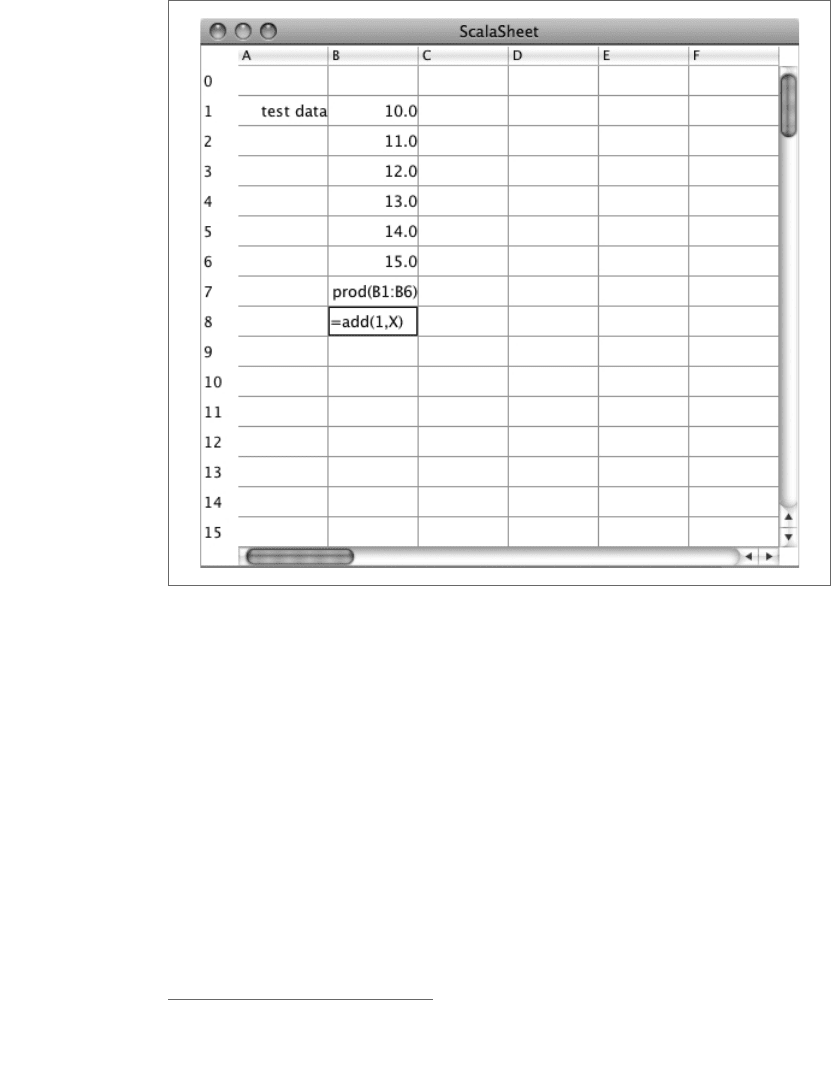Odersky M. Programming in Scala
Подождите немного. Документ загружается.


Section 33.4 Chapter 33 · The SCells Spreadsheet 691
Coord for cell coordinates such as A3,
Range for cell ranges such as A3:B17,
Number for floating-point numbers such as 3.1415,
Textual for textual labels such as Deprecation,
Application for function applications such as sum(A1,A2).
Each case class overrides the toString method so that it displays its kind of
formula in the standard way shown above. For convenience there’s also an
Empty object that represents the contents of an empty cell. The Empty object
is an instance of the Textual class with an empty string argument.
33.4 Parsing formulas
In the previous section you saw the different kinds of formulas and how
they display as strings. In this section you’ll see how to reverse the pro-
cess: that is, how to transform a user input string into a Formula tree. The
rest of this section explains one by one the different elements of a class
FormulaParsers, which contains the parsers that do the transformation.
The class builds on the combinator framework given in Chapter 31. Specif-
ically, formula parsers are an instance of the RegexParsers class explained
in that chapter:
package org.stairwaybook.scells
import scala.util.parsing.combinator._
object FormulaParsers extends RegexParsers {
The first two elements of the FormulaParser class are auxiliary parsers
for identifiers and decimal numbers:
def ident: Parser[String] = """[a-zA-Z_]\w
*
""".r
def decimal: Parser[String] = """-?\d+(\.\d
*
)?""".r
As you can see from the first regular expression above, an identifier starts
with a letter or underscore. This is followed by an arbitrary number of
“word” characters represented by the regular expression code \w, which rec-
ognizes letters, digits or underscores. The second regular expression de-
scribes decimal numbers, which consist of an optional minus sign, one or
more digits that are represented by regular expression code \d, and an op-
tional decimal part consisting of a period followed by zero or more digits.
Cover · Overview · Contents · Discuss · Suggest · Glossary · Index

Section 33.4 Chapter 33 · The SCells Spreadsheet 692
The next element of class FormulaParsers is the cell parser, which
recognizes the coordinates of a cell, such as C11 or B2. It first calls a regular
expression parser that determines the form of a coordinate: a single letter
followed by one or more digits. The string returned from that parser is then
converted to a cell coordinate by separating the letter from the numerical part
and converting the two parts to indices for the cell’s column and row:
def cell: Parser[Coord] =
"""[A-Za-z]\d+""".r ˆˆ { s =>
val column = s.charAt(0) - 'A'
val row = s.substring(1).toInt
Coord(row, column)
}
Note that the cell parser is a bit restrictive in that it allows only column
coordinates consisting of a single letter. Hence the number of spreadsheet
columns is in effect restricted to be at most 26, because further columns
cannot be parsed. It’s a good idea to generalize the parser so that it accepts
cells with several leading letters. This is left as an exercise to you.
The range parser recognizes a range of cells. Such a range is composed
of two cell coordinates with a colon between them:
def range: Parser[Range] =
cell~":"~cell ˆˆ {
case c1~":"~c2 => Range(c1, c2)
}
The number parser recognizes a decimal number, which is converted to
a Double and wrapped in an instance of the Number class:
def number: Parser[Number] =
decimal ˆˆ (d => Number(d.toDouble))
The application parser recognizes a function application. Such an ap-
plication is composed of an identifier followed by a list of argument expres-
sions in parentheses:
def application: Parser[Application] =
ident~"("~repsep(expr, ",")~")" ˆˆ {
case f~"("~ps~")" => Application(f, ps)
}
Cover · Overview · Contents · Discuss · Suggest · Glossary · Index

Section 33.4 Chapter 33 · The SCells Spreadsheet 693
The expr parser recognizes a formula expression—either a top-level for-
mula following an ‘=’, or an argument to a function. Such a formula expres-
sion is defined to be a cell, a range of cells, a number, or an application:
def expr: Parser[Formula] =
range | cell | number | application
This definition of the expr parser contains a slight oversimplification be-
cause ranges of cells should only appear as function arguments; they should
not be allowed as top-level formulas. You could change the formula gram-
mar so that the two uses of expressions are separated, and ranges are ex-
cluded syntactically from top-level formulas. In the spreadsheet presented
here such an error is instead detected once an expression is evaluated.
The textual parser recognizes an arbitrary input string, as long as it
does not start with an equals sign (recall that strings that start with ‘=’ are
considered to be formulas):
def textual: Parser[Textual] =
"""[ˆ=].
*
""".r ˆˆ Textual
The formula parser recognizes all kinds of legal inputs into a cell. A
formula is either a number, or a textual entry, or a formula starting with an
equals sign:
def formula: Parser[Formula] =
number | textual | "="~>expr
This concludes the grammar for spreadsheet cells. The final method
parse uses this grammar in a method that converts an input string into a
Formula tree:
def parse(input: String): Formula =
parseAll(formula, input) match {
case Success(e, _) => e
case f: NoSuccess => Textual("["+ f.msg +"]")
}
} //end FormulaParsers
The parse method parses all of the input with the formula parser. If
that succeeds, the resulting formula is returned. If it fails, a Textual object
with an error message is returned instead.
Cover · Overview · Contents · Discuss · Suggest · Glossary · Index

Section 33.4 Chapter 33 · The SCells Spreadsheet 694
package org.stairwaybook.scells
import swing._
import event._
class Spreadsheet(val height: Int, val width: Int) ... {
val table = new Table(height, width) {
...
reactions += {
case TableUpdated(table, rows, column) =>
for (row <- rows)
cells(row)(column).formula =
FormulaParsers.parse(userData(row, column))
}
}
}
Listing 33.6 · A spreadsheet that parses formulas.
That’s everything there is to parsing formulas. The only thing that re-
mains is to integrate the parser into the spreadsheet. To do this, you can
enrich the Cell class in class Model by a formula field:
case class Cell(row: Int, column: Int) {
var formula: Formula = Empty
override def toString = formula.toString
}
In the new version of the Cell class, the toString method is defined to
display the cell’s formula. That way you can check whether formulas have
been correctly parsed.
The last step in this section is to integrate the parser into the spreadsheet.
Parsing a formula happens as a reaction to the user’s input into a cell. A com-
pleted cell input is modeled in the Swing library by a TableUpdated event.
The TableUpdated class is contained in package scala.swing.event. The
event is of the form:
TableUpdated(table, rows, column)
It contains the table that was changed, as well as a set of coordinates of
affected cells given by rows and column. The rows parameter is a range
Cover · Overview · Contents · Discuss · Suggest · Glossary · Index

Section 33.4 Chapter 33 · The SCells Spreadsheet 695
Figure 33.3 · Cells displaying their formulas.
value of type Range[Int].
2
The column parameter is an integer. So in
general a TableUpdated event can refer to several affected cells, but they
would be on a consecutive range of rows and share the same column.
Once a table is changed, the affected cells need to be re-parsed. To re-
act to a TableUpdated event, you add a case to the reactions value of
the table component, as is shown in Listing 33.6. Now, whenever the ta-
ble is edited the formulas of all affected cells will be updated by parsing the
corresponding user data. When compiling the classes discussed so far and
launching the scells.Main application you should see a spreadsheet appli-
cation like the one shown in Figure 33.3. You can edit cells by typing into
them. After editing is done, a cell displays the formula it contains. You can
2
Range[Int] is also the type of a Scala expression such as “1 to N”.
Cover · Overview · Contents · Discuss · Suggest · Glossary · Index

Section 33.5 Chapter 33 · The SCells Spreadsheet 696
also try to type some illegal input such as the one reading =add(1, X) in
the field that has the editing focus in Figure 33.3. Illegal input will show
up as an error message. For instance, once you’d leave the edited field in
Figure 33.3 you should see the error message [`(' expected] in the cell (to
see all of the error message you might need to widen the column by dragging
the separation between the column headers to the right).
33.5 Evaluation
Of course, in the end a spreadsheet should evaluate formulas, not just display
them. In this section, we’ll add the necessary components to achieve this.
What’s needed is a method, evaluate, which takes a formula and re-
turns the value of that formula in the current spreadsheet, represented as a
Double. We’ll place this method in a new trait, Evaluator. The method
needs to access the cells field in class Model to find out about the current
values of cells that are referenced in a formula. On the other hand, the Model
class needs to call evaluate. Hence, there’s a mutual dependency between
the Model and the Evaluator. A good way to express such mutual depen-
dencies between classes was shown in Chapter 27: you use inheritance in
one direction and self types in the other.
In the spreadsheet example, class Model inherits from Evaluator and
thus gains access to its evaluation method. To go the other way, class
Evaluator defines its self type to be Model, like this:
package org.stairwaybook.scells
trait Evaluator { this: Model => ...
That way, the this value inside class Evaluator is assumed to be Model
and the cells array is accessible by writing either cells or this.cells.
Now that the wiring is done, we’ll concentrate on defining the contents of
class Evaluator. Listing 33.7 shows the implementation of the evaluate
method. As you might expect, the method contains a pattern match over
the different types of formulas. For a coordinate Coord(row, column),
it returns the value of the cells array at that coordinate. For a number
Number(v), it returns the value v. For a textual label Textual(s), it returns
zero. Finally, for an application Application(function, arguments), it
computes the values of all arguments, retrieves a function object correspond-
Cover · Overview · Contents · Discuss · Suggest · Glossary · Index

Section 33.5 Chapter 33 · The SCells Spreadsheet 697
def evaluate(e: Formula): Double = try {
e match {
case Coord(row, column) =>
cells(row)(column).value
case Number(v) =>
v
case Textual(_) =>
0
case Application(function, arguments) =>
val argvals = arguments flatMap evalList
operations(function)(argvals)
}
} catch {
case ex: Exception => Math.NaN_DOUBLE
}
Listing 33.7 · The evaluate method of trait Evaluator.
ing to the function name from an operations table and applies that func-
tion to all argument values.
The operations table maps function names to function objects. It is
defined as follows:
type Op = List[Double] => Double
val operations = new collection.mutable.HashMap[String, Op]
As you can see from this definition, operations are modeled as functions
from lists of values to values. The Op type introduces a convenient alias for
the type of an operation.
The computation in evaluate is wrapped in a try-catch to guard against
input errors. There are actually quite a few things that can go wrong when
evaluating a cell formula: coordinates might be out of range; function names
might be undefined; functions might have the wrong number of arguments;
arithmetic operations might be illegal or overflow. The reaction to any of
these errors is the same: a “not-a-number” value is returned. The returned
value, Math.NaN_DOUBLE is the IEEE representation for a computation that
does not have a representable floating-point value. This might happen be-
cause of an overflow or a division by zero, for example. The evaluate
Cover · Overview · Contents · Discuss · Suggest · Glossary · Index

Section 33.5 Chapter 33 · The SCells Spreadsheet 698
method of Listing 33.7 chooses to return the same value also for all other
kinds of errors. The advantage of this scheme is that it’s simple to under-
stand and doesn’t require much code to implement. Its disadvantage is that
all kinds of errors are lumped together, so a spreadsheet user does not get
any detailed feedback on what went wrong. If you wish you can experiment
with more refined ways of representing errors in the SCells application.
The evaluation of arguments is different from the evaluation of top-level
formulas. Arguments may be lists whereas top-level functions may not. For
instance, the argument expression A1:A3 in sum(A1:A3) returns the values
of cells A1, A2, A3 in a list. This list is then passed to the sum operation. It’s
also possible to mix lists and single values in argument expressions, for in-
stance the operation sum(A1:A3, 1.0, C7), which would sum up five values.
To handle arguments that might evaluate to lists, there’s another evaluation
function, called evalList. This function takes a formula and returns a list
of values. Here is its definition:
private def evalList(e: Formula): List[Double] = e match {
case Range(_, _) => references(e) map (_.value)
case _ => List(evaluate(e))
}
If the formula argument passed to evalList is a Range, the returned value is
a list consisting of the values of all cells referenced by the range. For every
other formula the result is a list consisting of the single result value of that
formula. The cells referenced by a formula are computed by a third function,
references. Here is its definition:
def references(e: Formula): List[Cell] = e match {
case Coord(row, column) =>
List(cells(row)(column))
case Range(Coord(r1, c1), Coord(r2, c2)) =>
for (row <- (r1 to r2).toList; column <- c1 to c2)
yield cells(row)(column)
case Application(function, arguments) =>
arguments flatMap references
case _ =>
List()
}
} // end Evaluator
Cover · Overview · Contents · Discuss · Suggest · Glossary · Index

Section 33.6 Chapter 33 · The SCells Spreadsheet 699
The references method is actually more general than needed right now
in that it computes the list of cells referenced by any sort of formula, not
just a Range formula. It will turn out later that the added functionality is
needed to compute the sets of cells that need updating. The body of the
method is a straightforward pattern match on kinds of formulas. For a coor-
dinate Coord(row, column), it returns a single-element list containing the
cell at that coordinate. For a range expression Range(coord1, coord2), it
returns all cells between the two coordinates, computed by a for expression.
For a function application Application(function, arguments), it returns
the cells referenced by each argument expression, concatenated via flatMap
into a single list. For the other two types of formulas, Textual and Number,
it returns an empty list.
33.6 Operation libraries
The class Evaluator itself defines no operations that can be performed on
cells: its operations table is initially empty. The idea is to define such oper-
ations in other traits, which are then mixed into the Model class. Listing 33.8
shows an example trait that implements common arithmetic operations:
package org.stairwaybook.scells
trait Arithmetic { this: Evaluator =>
operations += (
"add" -> { case List(x, y) => x + y },
"sub" -> { case List(x, y) => x - y },
"div" -> { case List(x, y) => x / y },
"mul" -> { case List(x, y) => x
*
y },
"mod" -> { case List(x, y) => x % y },
"sum" -> { xs => (0.0 /: xs)(_ + _) },
"prod" -> { xs => (1.0 /: xs)(_
*
_) }
)
}
Listing 33.8 · A library for arithmetic operations.
Interestingly, this trait has no exported members. The only thing it does
is populate the operations table during its initialization. It gets access to
Cover · Overview · Contents · Discuss · Suggest · Glossary · Index

Section 33.6 Chapter 33 · The SCells Spreadsheet 700
that table by using a self type Evaluator, i.e., by the same technique the
Arithmetic class uses to get access to the model.
Of the seven operations that are defined by the Arithmetic trait, five are
binary operations and two take an arbitrary number of arguments. The binary
operations all follow the same schema. For instance, the addition operation
add is defined by the expression:
{ case List(x, y) => x + y }
That is, it expects an argument list consisting of two elements x and y and
returns the sum of x and y. If the argument list contains a number of elements
different from two, a MatchError is thrown. This corresponds to the general
“let it crash” philosophy of SCell’s evaluation model, where incorrect input
is expected to lead to a runtime exception that then gets caught by the try-
catch inside the evaluation method.
The last two operations, sum and prod, take a list of arguments of arbi-
trary length and insert a binary operation between successive elements. So
they are instances of the “fold left” schema that’s expressed in class List by
the /: operation. For instance, to sum a list of numbers List(x, y, z), the
operation computes 0 + x + y + z. The first operand, 0, is the result if the list
is empty.
You can integrate this operation library into the spreadsheet application
by mixing the Arithmetic trait into the Model class, like this:
package org.stairwaybook.scells
class Model(val height: Int, val width: Int)
extends Evaluator with Arithmetic {
case class Cell(row: Int, column: Int) {
var formula: Formula = Empty
def value = evaluate(formula)
override def toString = formula match {
case Textual(s) => s
case _ => value.toString
}
}
... // rest as before
}
Cover · Overview · Contents · Discuss · Suggest · Glossary · Index
